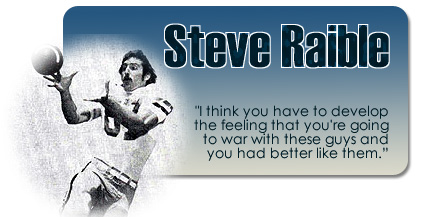Steve Raible was there!
He was there in the Kingdome from the start, followed in the broadcast booth and has now written a book about the Seahawks!
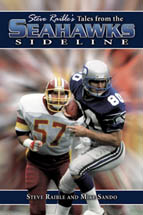
Steve Raible's Tales from the Seahawks Sidelines
Steve Raible's book that was released in 2004 can be ordered direct from the publisher, Sports Publishing, LLC, from Amazon.com or Barnes & Noble, or from your favorite bookseller. Part of the proceeds will be donated to the Pete Gross House.
Seahawks
by Doug Thiel
Sunrise Publishing Inc.
The draft also allowed the Seahawks another second round bonus, Steve Raible, Georgia Tech. As the Rambling Wrecks’ fastest player Steve was clocked at 4.35 seconds for a forty yard dash and caught 13 passes for 275 yards and four touchdowns his senior year. Four players were selected in the first two rounds of drafting, and the Seahawks were happy.
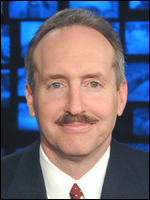
Hawks' Ring Of Honor Welcomes Zorn
Sports: Sunday, August 04, 1991
Tom Farrey
More than 350 players have given the Seahawks and their fans memories in the franchise's 16-year existence. Only two of them give the club a history. Steve Largent, and now, Jim Zorn.
"I look out on the turf and think, `That's where Steve Raible got a punctured lung,' " Zorn said. "There's where Lyle Alzado knocked the wind out of me."
Smith 'A Pleasure to Watch'
Source: Seattle PI
By Don Fair
"Steve Raible (out with an injury) and Wayne Johnson (a free agent) have been the outstanding wide receivers. Raible and Sherman Smith dropped only one pass in the first five days of camp."Rookie guards Steve Duncanson (free agent) and Jeff Urozyk (16th round draftee) are among lower-ranked players who have a chance to stick a little bit longer."

Pro Football 1976
by Larry Felser and Dave Klein
Wide receivers aren’t bad. The starters figure to be Alamad Rashad and Sam McCullum, but two rookie picks, Sherman Smith and Steve Raible, and veteran Don Clune will fight for steady work. John McMakin and Ron Howard will battle young Charles Waddell for the tight end spot.Rashad, obtained via the option-playout route, is a tried and true star. McCullum is experienced and could be a top receiver. McMakin, also experienced, is a strong blocker. Clune was a mystery with the Giants. Scouts and teammates say he should have played more; the coach didn’t agree. Picard never realized his potential and will get his chance. Howard, another of Dallas’ basketball players, showed promise. High draft picks Smith and Raible have enormous potential; one of them might even start. Waddell may be a find, too. The Chargers gamble leaving him unprotected.
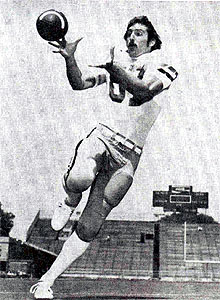

Vikings slip past Seahawks 27-21
By Allan HolbertMinneapolis Tribune
Nov. 15, 1976 Seattle tied it up again early in the third quarter when Zorn, standing on his own 10-yard line threw to the speedy Steve Raible who beat Nate Allen, caught it on the Vikings 45 and raced, untouched to the end zone.
"We knew it would work sooner or later," said Raible. "Their linebackers were dropping back about 15 yards and then freezing there waiting to see where we'd throw. With them behind me I knew I could beat Allen."
"He beat me," said Allen. "They told us he was fast. They warned me. Now I'm a believer."
Street and Smith's Pro Football 1977
When he wasn't throwing to Largent, Zorn looked for tight end Ron Howard, the ex-Seattle U. basketball player, most often. The ex-Cowboy caught 37 passes in his first role as a starting tight end. The other wide receiver, Sam McCullum, caught 32 balls. He and Largent caught four touchdown passes. The experienced subs are tight end John McMakin and wide receiver Steve Raible.
New and Improved / Half a Season into Existence, the NFL'S Newest Expansion Teams are More Feared than Intimidated
The News Tribune
Nov 10, 1995
By John Clayton
The Seahawks scrubbed their entire starting backfield three days before their franchise debut and put receivers Steve Largent and Steve Raible at the running back positions in a passing offense.
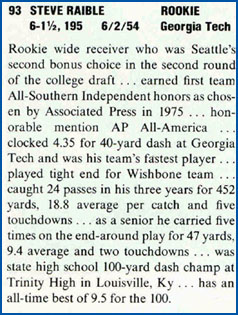
Cheney All About Concentration and Fence Mending
Source: The News Tribune
Mar 6, 1997
By DAVE BOLING, News Tribune columnist
KIRO-TV news anchor Steve Raible, a Seahawks receiver from 1976 through 1981, likes the notion of the team returning to Cheney - now that he doesn't have to sweat through it himself."I know I wasn't crazy about it when I was doing it, but now I think it's a good thing. I mean, really, over there, there is only one thing to focus on," he said. "It's a nice little town with nice people, but there's not much to do."
Except get to know your teammates.
"We used to do all kinds of training camp stunts," Raible said, recalling one nocturnal prank of jacking up coach Jack Patera's car and putting it on blocks, along with the usual fire extinguisher antics in the dorm.
"We used to go to Nick Bebout's room after curfew and throw back a few beers," he said. "Hey, it had been 100 degrees and you had to replenish your fluids. He used to sit there with a toilet seat around his neck - I have no idea why - and strum his guitar and drink beer." And the sense of shared hardship and privation pays dividends later, during the season.
"I think you have to develop the feeling that you're going to war with these guys and you had better like them," Raible said.
Another major difference for the Seahawks in Cheney will be that the practices will be open to the public.
And if Raible had any advice for the Seahawks, it is to take advantage of that access to the fans.
"I'd suggest they go over there and be ready to meet a lot of good people," Raible said. "People used to pull their cars and their trailers right up on the wheat fields around the practice fields. And after practice, they'd get autographs and meet us. It had a real nice feel to it.
"So I'd like to see (the Seahawks) go over there and not pull any of this star crap, that they don't need to sign autographs, or stop to talk to kids, because that's not what this team needs right now. "It needs a good dose of public relations and this could be it."
Steve Raible Receives NCAA Silver Anniversary Award
Former Yellow Jacket football standout is one of six honored.
Source: theacc.ocsn.com
Nov. 1, 2000
ATLANTA -- Former Georgia Tech football standout Steve Raible, now an award-winning television news anchor, is one of six recipients of the NCAA Silver Anniversary Award, the NCAA Honors Committee announced Wednesday. The Silver Anniversary Award recognizes former student-athletes who have distinguished themselves since completing their college athletics careers 25 years ago.
Raible is the fourth former Tech student-athlete to receive this prestigious honor, joining former football all-America Larry Morris, who was honored in 1980, and basketball standouts Pete Silas (1978) and Roger Kaiser (1986). Raible was an honorable mention all-America and all-Southeastern Independent as a receiver/tight end for the Yellow Jackets in 1975. A three-year letterman, he was an outstanding blocker who caught 24 passes for 342 yards and five touchdowns in Tech's run-dominated, wishbone offense. He was selected as the tight end on Georgia Tech's all-era team from 1967-79.
The two-sport standout also excelled in track, earning Georgia Collegiate Track Runner of the Year honors in 1974. He received a bachelor of science degree in industrial management in 1976 and was named Tech's top student-athlete that year.
Raible was selected in the second round of the 1976 NFL draft and became an original member of the Seattle Seahawks, for whom he played six years as a part-time starter and special teams player from 1976-81. His career totals are 68 receptions for 1,017 yards and three touchdowns.
A news anchor for Seattle's KIRO-TV (CBS affiliate) since 1992, Raible anchors the station's 5 p.m., 6:30 p.m. and 11 p.m. weekday newscasts. He is a five-time Emmy winner and has twice been named Best Anchor.
Raible has also worked as the color analyst for the Seahawks's radio broadcasts since 1982. Active in the Seattle community, Raible serves as a spokesman for the city's Ronald McDonald House. He has won the Outstanding Role Model Award from Big Brothers/Big Sisters and a community service award from the Boy Scouts of America and twice has been named the United Way Volunteer of the Year in Seattle/King County.
Also in this year's class are Alpha Alexander, College of Wooster, Archie Griffin, Ohio State, Steve Largent, Tulsa, Lee Roy Selmon, Oklahoma, and Wally Walker, Virginia.
Seahawks Hawk Q&A: Steve Raible
By Terry Wood
Special to The Seattle Times
December 25, 2001
Seattle Times
Seahawks broadcaster Steve Raible has been with the team since the first year, 1976. Raible was a receiver for six seasons, then moved into the radio booth, where he has been for the past 20 years.
Seattle Times: How would you summarize your career as a Seahawks player?
Steve Raible: In a word, how does mediocre sound? He gives me a hard time about it, but one day Mike Holmgren paid me a compliment. He said, "No matter what anybody says, you played in the National Football League for six years, so it's not like you were just there for a cup of coffee." I had to do something right, I guess. I suppose I'd summarize it by saying I was a team player. I did everything they asked me to do.
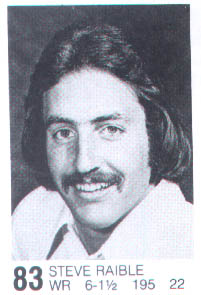
ST: Do you remember your first contract?
SR: Like it was yesterday. A three-year deal: $27, $35 and $43. That's thousands. And I got a $15,000 signing bonus, except it was spread over all three years. I think the most I ever made was my last year (1981), a little less than $100,000, and that was because I got some special teams' bonuses.
ST: As a wide receiver, did you mind playing special teams?
SR: Jack Patera (Seattle's first head coach) always said, "The more things you can do, the longer you're liable to be around here." So I would volunteer for just about everything. I never hesitated to play special teams. I made my share of tackles and was a pretty fair blocker. My weakness was I was not a very accomplished route-runner. With the wishbone (at Tech) you didn't run pass routes per se. (Fellow rookies) Sam McCullum and Steve Largent were great pass-route runners. I had to learn all that. And my hands weren't as good as Largent's, without question. So I did as much as I could do.
ST: Any memorable thrills?
SR: I didn't score a whole lot of touchdowns, but I caught an 80-yarder against the Vikings in my rookie year, at the old Vet in Minneapolis on a cold day in November.
ST: What led you to broadcasting?
SR: I had done some work in radio and television in the offseason for a couple of years. In June of 1982, just as I was ready to go to training camp, Pete Gross called our house. I was gone, and Sharon (Raible's wife) answered the phone. Pete said, "Sharon, sit down. I want to talk to you for a while."
The gist of that conversation was: Steve is never going to be Pro Bowler; he's always going to have Largent in front of him. But KIRO needs a new color radio guy for the Seahawks, and we want a guy to back up Wayne Cody on TV sports. Wayne almost strangled me when I told him I had to think about it. He said, "Are you insane? No one will ever have the opportunity to come out of football and learn on the job. If you pass it up, you're nuts." Wayne spoke from experience. He worked in places like Twin Bluffs, Neb., to work his way up to a job like Seattle. He said, "You can't play football forever, and you may only have one year left in you. You better think about it."
I came home, and Sharon and I talked about it a lot. I guess the last piece of the puzzle was I went to the Seahawks' office and talked to my position coach at that time, Rusty Tillman. He said "Rabes, I think you could still play. However, after all the years I gave the Redskins, one day they cut me. To this day, I always wished I had made the decision to retire for myself." That made a lot of sense to me. So I retired at the end of June and at the end of July I was working at KIRO.

ST: How did you adjust?
SR: That first season, 1982, was the strike year, so it was a little dicey. The guys were out for four or five weeks, and in my capacity as a TV sports guy I also had to cover that story. That made for some odd feelings among some of the players, because a few weeks before I was standing there with them and now I'm covering the story. The players didn't get a lot of sympathy from the public. But it worked out, and I did the rest of the season.
I started doing the noon newscast at KIRO in '84 or '85, and ultimately Wayne moved to radio only, so I became the sports director in the late '80s. Around 1992 or '93 they decided to change the format here and wanted me to just do news. I've been the main news anchor since then.
ST: After doing color for 20 years, is it still fun?
SR: Dennis Erickson asked me one time: "Why the hell do you keep doing this? You're the main anchor at the television station; you make decent money. You don't need to do this." I said, "Dennis, I do it for the same reason you do it: For the juice." There's something about a football game on Sunday and there's nothing else like it. I enjoy still being part of it, though it's kind of vicarious today. It's tough for me. I try not to be a homer on game day. I try to tell it like it is. But I love it when the team wins. I like the excitement of a big victory and what it means to the coaches and players. So I still get an adrenaline rush, too, and that carries over to the broadcast. It should.
ST: How would you describe your radio style?
SR: I don't want to say laid-back, but I'm not a crazy man. I don't scream and yell and carry on. I'd like it to be knowledgeable, at times witty, informed and descriptive. I want to paint this picture for the fans so that they can understand it.
ST: Has it been tough working with four different play-by-play announcers in 20 years?
SR: It hasn't. I've worked with four good ones. They've accommodated me and I've gotten along with all of them. I learned the business from Pete, so I will always be beholden to him for all he taught me about calling the games, and how much fun he made it for me as a young guy in learning the business.
Steve Thomas was a trooper. Steve had a very difficult job following Pete after he died. People all but made Pete a saint in this town. The only reason Steve did games for only a couple of years was because the management (at KIRO) changed. This business is so subjective. My general manager could change tomorrow and I could be on the street.
Lee Hamilton was brought in like a freelancer, and his was a much different style, with a much harder edge from doing talk radio in San Diego for many years. Lee was very good, and had lots of inside information. Then the Seahawks wanted their own guy who could be in-house. So they brought in Brian. We've become great friends and enjoy each other's company very much.
ST: Brian's very energetic. Some people might say he's loud.
SR: (Laughs.) Brian seems loud to himself at times. We've talked about it. He knows it and he's dialed it back about a notch from a year ago. He gets excited when the big play happens. We've discussed that there's a difference between being loud and being emphatic. You can give that sense of excitement and really punch that play without blowing somebody's headset off. I think he does a great job. He sure makes it exciting for me. He gets me up. There are times when I have to put the eardrops in after a game, but that's all right. I like the excitement.
ST: Got any favorite memories from the booth?
SR: The most exciting season, and it's a shame it has to be so long ago, was the '83 season and the playoff win over the Raiders. I was still close to a lot of those guys, my ex-teammates, and I was so happy for them. Mike winning the division in his first year in '99 was good; it got those feelings going again that this team could get back to the playoffs. I enjoyed the last night in the Kingdome, when so many coaches and players came back.
The most poignant moment, obviously, was Pete's last day. On that night (Nov. 30, 1992, a Monday night win over Denver in the Kingdome) when he was inducted into the Ring of Honor and three days later he died, I get very emotional thinking about that. Wayne and I got to unveil his name in the Ring. Wayne cried like a baby up there. I did all I could do to hold it back, and I didn't do a very good job. It was tough because we knew we were seeing the end. If you knew Pete, he hardly let on that he ever had a bad day in his life. I'm sure that he did, because two or three times he battled cancer before it finally got him. Just hearing him laugh let you know everything was OK. It's so overused, but people say it's tough to describe class, yet you know it when you see it. That was Pete.
ST: Among the job's downsides, malfunctioning elevators must be on your list. You got stuck in one after the game in Denver, in the team's brand-new stadium?
SR: For 45 minutes. There were seven of us in there, and we managed to find humor in it. Ironically, I got stuck in elevator in Denver more than 20 years ago when I was still playing. We were at the hotel and a bunch of us players piled into an elevator to go down for the team dinner. The way we used to do it, you had to put your coat and tie on whenever you left your room, so there's like 20 of us jammed inside this elevator and it stops.
There was barely room to move inside, and with everyone in coats that baby got hot in a hurry. We were in there for an hour. I remember Bob Newton at 270 pounds starting to get a little panicked. My nose was almost pressed against the door. When we finally got to dinner we were late and Jack (Patera) was going to fine us. We told him we were stuck in an elevator. "Yeah, right, that'll be $500." It took a while, but we finally convinced him. When I'm in Denver, I'm taking the stairs from now on.
ST: Which makes you prouder: your athletic career or broadcasting career?
SR: It's funny, as I get older I'm rather proud of the fact that I played football, because it seems like such a long time ago. The NCAA Silver Anniversary Award this year sent it home to me. Three of the six people this year had ties to Seattle: Wally Walker, Steve Largent and myself, plus Lee Roy Selmon, Archie Griffin and Alfa Alexander, a four-sport woman from Ohio State. The criteria is: You come out of school 25 years ago; what have you done in the 25 years since?
I've got no kind of college career that stands up to a two-time Heisman Award winner (Griffin), an Outland Trophy winner (Selmon), a Hall of Famer (Largent) or Wally, who led the nation in scoring in his senior year at Virginia. But I thought about the transition from a sports career into a serious news career and a deep involvement with a community and it made me reflect: You know, it wasn't that bad of a career, actually. I've done some things some other people didn't get a chance to do.
The Pocket Book of Pro Football 1976
Edited by Herbert M. Furlow
Former Steeler starter John McMakin may be the best of the lot. Ron Howard is another tight end; he may try for the top job. He was on Dallas special teams. Don Clune was little used by the Giants but when given time did well; he has speed, but little experience. Sam McCullum also doubles as a kick returner. He hurt a shoulder in 1975. Raible, a rookie, hopes to break in.
A Seahawk Blueprint: from expansion to contention
Source: Norm Evans’ Seahawk Report, Oct. 29 – Nov. 4, 1979
By Gary Huff
The bulk of the Seahawks first team in 1976 came, of course, from the veteran allocations draft. Many of those drafted merely filled positions until the college draft could provide quality replacements. Only four of those expansion draftees, Nick Bebout, Art Kuehn, Sam McCullum and Dave Brown remain today.
The Hawks' first-year college draft, while tainted with a few drafting errors, added five quality players. The selection of Steve Niehaus, the team's initial first-rounder, must now be regarded as one of the team's larger draft mistakes. In the third and fourth rounds, where a team should come up with some fine down-the-road players, the Hawks bombed. Jeff Lloyd (DL) and Randy Johnson (OG) didn't survive training camp. Rick Engles (P), Don Bitterlich (K) and Andrew Bolton (RB) didn't last much longer. All of these players have had shots with other teams, but their careers are essentially over.
Despite these shortcomings, the `76 draft did produce some important members of the `79 team: Sammy Green, Sherman Smith, Steve Raible (all in the second round), Steve Myer (4th) and Don Dufek (5th).
Seattle's Don Clune looking for place to play
By GENE GOMOLKA
Daily Times Staff Writer
Delaware County Daily Times
Saturday, December 11, 1976
One of the reasons the Giants were ready to release
Clune was because he had informed them he would be
playing out his option year and very likely would make a
deal with another team after the season.In March, he became the property of the Seahawks who selected 39 NFL veterans. Seattle also drafted 25 collegians, including wide receiver Steve Raible out of Georgia Tech. The Seahawks then traded for Steve Largent, a rookie wide receiver from Tulsa who had been Houston's fourth-round draft choice.
Largent became a phenomenon while Clune watched from the sidelines. Largent, voted Seattle's rookie of-the-year and offensive player of-the-year, has caught 47 passes for 607 yards and three touchdowns. Raible has four for 126 yards, including an 80-yard touchdown. McCullum has four touchdowns among his 29 receptions for 495 yards.
Collecting Steve Raible?
1976 Post-Intelligencer mini poster #451980 Seahawks Police


